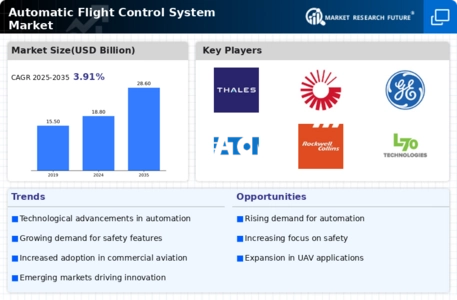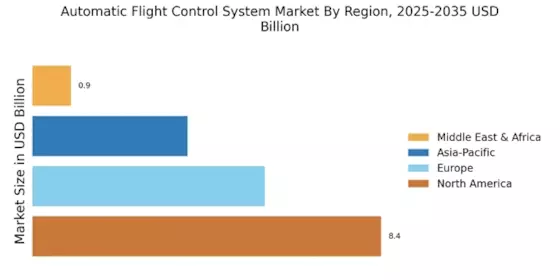Rising Demand for Fuel Efficiency
In the Automatic Flight Control System Market, the increasing emphasis on fuel efficiency is a pivotal driver. Airlines are under constant pressure to reduce operational costs, and fuel consumption constitutes a significant portion of these expenses. Advanced flight control systems enable optimized flight paths and improved aerodynamic performance, which can lead to substantial fuel savings. Reports suggest that implementing modern automatic flight control systems can reduce fuel consumption by up to 10%. This potential for cost reduction is compelling airlines to adopt these systems, thereby propelling market growth and innovation in the sector.
Technological Advancements in Aviation
The Automatic Flight Control System Market is experiencing a surge in technological advancements, particularly in avionics and control systems. Innovations such as fly-by-wire technology and advanced autopilot systems are enhancing aircraft performance and safety. According to recent data, the market for avionics is projected to reach USD 80 billion by 2026, indicating a robust growth trajectory. These advancements not only improve operational efficiency but also reduce pilot workload, making air travel safer and more reliable. As airlines and manufacturers invest in modernizing their fleets, the demand for sophisticated automatic flight control systems is likely to increase, driving market growth.
Growing Air Traffic and Fleet Expansion
The Automatic Flight Control System Market is significantly influenced by the growing air traffic and the expansion of commercial fleets. With the International Air Transport Association forecasting a doubling of air traffic by 2037, the demand for efficient and reliable flight control systems is expected to rise correspondingly. Airlines are increasingly investing in new aircraft equipped with advanced automatic flight control systems to accommodate this surge in passenger numbers. This trend not only enhances operational efficiency but also ensures compliance with stringent safety regulations, further driving the market's expansion.
Increased Focus on Safety and Reliability
Safety remains a paramount concern in the aviation sector, and the Automatic Flight Control System Market is responding to this need with enhanced reliability features. The integration of redundant systems and advanced monitoring technologies is becoming standard practice in modern aircraft. Regulatory bodies are mandating higher safety standards, which necessitate the adoption of sophisticated flight control systems. As a result, manufacturers are prioritizing the development of systems that not only meet but exceed these safety requirements. This focus on safety is likely to stimulate demand for advanced automatic flight control systems, thereby fostering market growth.
Emergence of Unmanned Aerial Vehicles (UAVs)
The rise of unmanned aerial vehicles (UAVs) is reshaping the Automatic Flight Control System Market. As UAV applications expand across various sectors, including agriculture, surveillance, and logistics, the demand for advanced flight control systems tailored for these platforms is increasing. UAVs require sophisticated automatic flight control systems to ensure stability, navigation, and autonomous operation. The market for UAVs is projected to grow significantly, with estimates suggesting a value of USD 58 billion by 2026. This burgeoning sector presents a unique opportunity for innovation and growth within the automatic flight control systems market.


















Leave a Comment